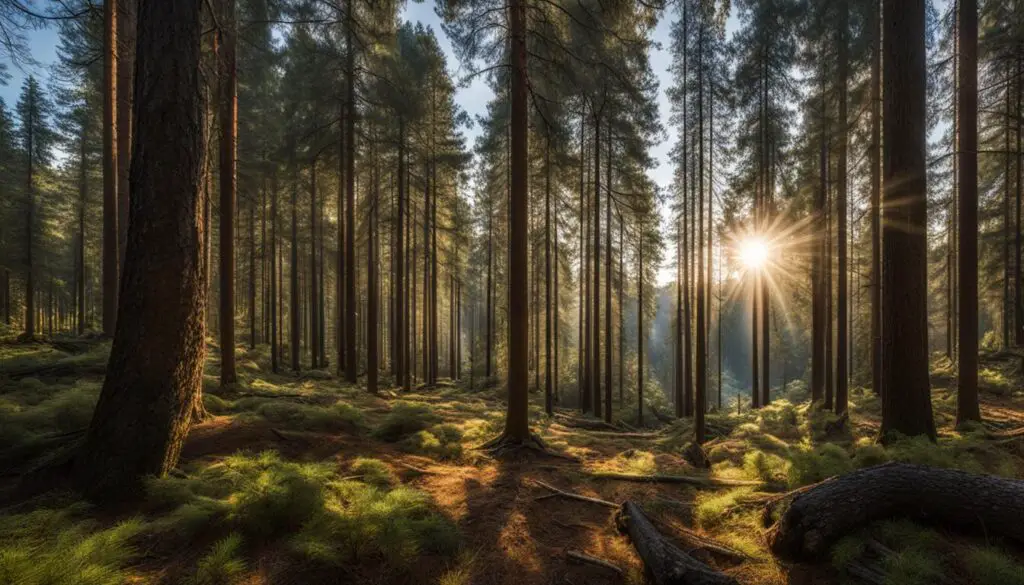Pine trees, a subgroup of conifers, can be found in various habitats around the world. They are known for their whorled clumps of needles and unique pine cones. Pine habitats often have well-drained sandy soils, although specific soil and moisture requirements can vary among different pine species. Pine trees provide a rich habitat for wildlife, and they can be the first to colonize disturbed areas. Fire is a natural part of many pine ecosystems and can even help pine cones release their seeds. Different species of pines have adapted to different climates and can be found in various regions across the globe.
Key Takeaways:
- Pine trees can be found in diverse habitats worldwide, including forests, woodlands, and savannas.
- Well-drained sandy soils are often preferred by pine trees, although soil and moisture requirements can vary.
- Pine trees create a rich habitat for wildlife and are often the first to colonize disturbed areas.
- Fire plays a natural role in many pine ecosystems, helping to release seeds from pine cones.
- Various species of pine trees have adapted to different climates and can be found in regions across the globe.
Types of Pine Trees
Pine trees are known for their diverse range of species, with over 100 varieties falling under the genus Pinaceae. Each species possesses unique characteristics and flourishes in its preferred habitat. Let’s explore some well-known types of pine trees and their distinctive attributes.
1. Eastern White Pine
One prominent member of the pine tree family is the Eastern White Pine (Pinus strobus). This species is native to North America and is recognized for its elegant appearance and soft, bluish-green needles. Eastern White Pine trees are adaptable and can grow in various soil types.
2. Scots Pine
The Scots Pine (Pinus sylvestris) is a species of pine native to Europe and Asia. It is widely recognized by its orange-brown bark and long, twisted needles. The Scots Pine is known for its ability to tolerate harsh climates and is commonly found in mountainous regions.
3. Lodgepole Pine
The Lodgepole Pine (Pinus contorta) is prevalent in North America, particularly in western regions. It features dense clusters of needles and distinctive, cylindrical cones. Lodgepole Pine trees are highly adaptable and can thrive in a variety of habitats, including dry, nutrient-poor soils.
4. Ponderosa Pine
The Ponderosa Pine (Pinus ponderosa) is native to the western United States and Canada. It is characterized by its reddish-brown bark and long, yellow-green needles. Ponderosa Pines are adaptable to different elevations, ranging from lower valleys to high mountain slopes.
The wide diversity of pine tree species allows them to flourish in various environmental conditions. From coastal regions to high-altitude mountains, these resilient trees can be found across the globe, providing beauty and valuable ecosystem services.
| Pine Tree Species | Habitat | Notable Characteristics |
|---|---|---|
| Eastern White Pine | North America | Elegant appearance, soft bluish-green needles |
| Scots Pine | Europe, Asia | Orange-brown bark, long twisted needles |
| Lodgepole Pine | North America | Dense needle clusters, cylindrical cones |
| Ponderosa Pine | United States, Canada | Reddish-brown bark, long yellow-green needles |
Native Range and Distribution of Pine Trees
Pine trees are widely distributed in the Northern Hemisphere, with diverse species found across North America, Europe, and Asia. They thrive in a variety of ecosystems, including forests, woodlands, and savannas. The native range of pine trees is influenced by factors such as climate, soil conditions, and geographical barriers, resulting in different distribution patterns for each species.
For example, the majestic Longleaf Pine (Pinus palustris) is native to the southeastern United States, specifically in the coastal plain region. This species is well-adapted to the sandy soils and warm climate of the region, making it an important component of the local ecosystem.
On the other side of the globe, the Scots Pine (Pinus sylvestris) is native to Europe and Asia. It is commonly found in the boreal forests of northern Europe, where it thrives in cold climates and acidic soils.
Global Distribution of Pine Trees
While pine trees are most abundant in North America, Europe, and Asia, they can be found in various other parts of the world as well. Some species have been introduced to new regions and have become naturalized. The global distribution of pine trees highlights their adaptability and ability to establish themselves in different climates and environments.
Table: Native Range and Distribution of Selected Pine Tree Species
| Pine Tree Species | Native Range | Distribution |
|---|---|---|
| Longleaf Pine | Southeastern United States | Southeastern United States, parts of the Gulf Coast |
| Scots Pine | Europe, Asia | Europe, Asia, parts of North America |
| Eastern White Pine | Eastern North America | Eastern North America |
| Jack Pine | North America | North America |
These are just a few examples of the wide range of pine tree species and their respective native ranges and distributions. The adaptability of pine trees and their ability to thrive in various conditions make them a vital component of ecosystems around the world.

Ideal Conditions for Pine Tree Growth
Pine trees have specific requirements for optimal growth and development. Understanding these ideal conditions is essential for successfully cultivating and maintaining healthy pine tree populations.
Pine Tree Soil Requirements
Pine trees generally thrive in habitats with well-drained sandy soils. These soils allow for proper root development and prevent waterlogging, which can be detrimental to pine tree health. While pines can tolerate a range of soil types, including sandy loam, it is important to note that heavy clay soils or compacted loam soils are usually not favorable for their survival.
Some pine tree species, such as the Loblolly Pine, have a higher tolerance for moisture and can grow in soils with higher clay content. However, most pine species thrive in soils that provide adequate drainage.
Pine Tree Climate Preferences
Pine trees prefer climates with cool to mild winters and warm summers. They are well adapted to thrive in regions with a Mediterranean climate, such as coastal areas. Pines are also well-suited to temperate climates found in areas like the United States, Europe, and parts of Asia.
Specific climate preferences may vary among different pine species. Some pines are more tolerant of extreme cold temperatures, while others prefer milder climates. It is important to consider the specific climate requirements of the pine species being cultivated to ensure their successful growth.
Overall, when providing ideal conditions for pine tree growth, it is crucial to consider both soil requirements and climate preferences. By understanding and meeting these needs, you can create an environment that promotes the health and vitality of your pine trees.
Pine Tree Ecosystems
Pine trees play a crucial role in various ecosystems, contributing to the overall biodiversity and sustainability of these habitats. They provide vital habitat and food sources for a wide range of wildlife species, including birds, small mammals, and insects.
One of the key ecological roles of pine trees is their impact on bird populations. Many bird species rely on pine cones as a significant food source, as they contain seeds that are essential for their survival. Birds such as crossbills, grosbeaks, and certain finches have specialized beaks that allow them to extract seeds from pine cones. These birds depend on pine forests to find this important food resource.

Pine forests also provide critical nesting and foraging habitats for woodpeckers. These birds excavate cavities in pine trees for nesting, and they use their strong bills to search for insects and larvae beneath the bark. The presence of pine trees is essential for the survival of woodpecker populations.
Additionally, deer and wild turkeys are known to frequent pine forests that have a diverse understory. The dense canopy and fallen pine needles create an ideal environment for these animals to find shelter and forage for food. The pine forest understory often consists of grasses, shrubs, and other vegetation that provide additional resources and habitat for numerous wildlife species.
“Pine trees are often the first to colonize disturbed areas, such as after a fire or logging,” says Dr. Jane Collins, a wildlife biologist. “Their ability to thrive in these transitional habitats is remarkable. They create an ecological bridge, facilitating the establishment of other vegetation types and promoting the recovery of ecosystems.”
Effects on Wildlife
The wildlife habitat provided by pine trees not only supports a diverse array of animal species but also contributes to the overall functioning and resilience of ecosystems. These ecosystems are characterized by interactions between plants, animals, and their environment, creating a complex web of relationships.
- Pine trees offer shelter and protection to birds, small mammals, and insects.
- Pine forests provide nesting and foraging habitats for woodpeckers.
- The dense understory of pine forests attracts deer and wild turkeys.
- Pine trees create transitional habitats and promote ecosystem recovery.
“Pine trees are keystone species in many ecosystems,” says Dr. Amanda Patterson, a conservation biologist. “Their presence or absence can significantly impact the overall structure and function of these habitats, making them crucially important for conservation efforts.”
| Key Points | Summary |
|---|---|
| Pine trees provide habitat and food for a wide range of wildlife species. | Pine trees support bird populations that rely on pine cones for seeds. |
| Woodpeckers use pine forests for nesting and foraging. | The dense understory of pine forests attracts deer and wild turkeys. |
| Pine trees are often the first to colonize disturbed areas, creating transitional habitats. | The ecological role of pine trees is crucial for the overall functioning and resilience of ecosystems. |
Conclusion
Pine trees have a remarkable ability to thrive in diverse habitats, ranging from sandy coastal regions to high-altitude mountains. They are highly adaptable to different soil conditions and have specific climate preferences. The native range and distribution of pine trees cover various regions across the globe, contributing to the overall biodiversity of these areas.
Pine tree ecosystems play a vital role in providing wildlife habitat and supporting numerous species. They serve as crucial resources for birds, small mammals, and insects, offering shelter and food. Pine forests are especially significant for birds that rely on pine cones for their seeds. Additionally, pine trees are often the pioneers in disturbed areas, such as after a fire or logging, creating transitional habitats that foster the growth of other vegetation types.
Understanding the ideal conditions for pine tree growth, including soil requirements and climate preferences, is essential for proper conservation efforts and sustainable management of these valuable tree species. By protecting and managing pine tree habitats, we can ensure the continued presence of pine trees in our environment and preserve the ecosystems they support.
FAQ
Where do pine trees live?
Pine trees can be found in various habitats around the world, from sandy coastal regions to high-altitude mountains.
What are the types of pine trees?
There are over 100 species of pine trees, including the Eastern White Pine, Scots Pine, Lodgepole Pine, and Ponderosa Pine, among others.
What is the native range and distribution of pine trees?
Pine trees are primarily distributed in the Northern Hemisphere, with the majority of species found in North America, Europe, and Asia.
What are the ideal conditions for pine tree growth?
Pine trees prefer habitats with well-drained sandy soils and climates with cool to mild winters and warm summers.
What role do pine trees play in ecosystems?
Pine trees provide important wildlife habitat, serve as a food source for various animals, and can be the first to colonize disturbed areas.
Why is understanding pine tree habitats important?
Understanding pine tree habitats, including their native range, distribution, and ideal conditions for growth, is crucial for conservation and sustainable management of these valuable tree species.

